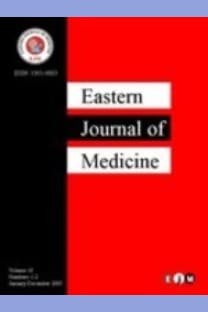Frostbite – From Turkish Eastern Border As A Consequence Of Irregular Migration
Frostbite – From Turkish Eastern Border As A Consequence Of Irregular Migration
___
- 1- Gross EA, Moore JC. Using thrombolytics in frostbite injury. J Emerg Trauma Shock. 2012;5(3):267-271. doi:10.4103/0974-2700.99709
- 2- Peck MD. Epidemiology of burns throughout the world. Part I: Distribution and risk factors. Burns. 2011;37(7):1087-1100. doi:10.1016/j.burns.2011.06.005
- 3- Smolle C, Cambiaso-Daniel J, Forbes AA, et al. Recent trends in burn epidemiology worldwide: A systematic review. Burns. 2017;43(2):249-257. doi:10.1016/j.burns.2016.08.013
- 4- Heil KM, Oakley EH, Wood AM. British Military freezing cold injuries: a 13-year review. J R Army Med Corps. 2016;162(6):413-418. doi:10.1136/jramc-2015-000445
- 5- DeGroot DW, Castellani JW, Williams JO, Amoroso PJ. Epidemiology of U.S. Army cold weather injuries, 1980-1999. Aviat Space Environ Med. 2003;74(5):564-570.
- 6- Shenaq DS, Gottlieb LJ. Cold Injuries. Hand Clin. 2017;33(2):257-267. doi:10.1016/j.hcl.2016.12.003
- 7- Nizamoglu, M., Tan, A., Vickers, T. et al. Cold burn injuries in the UK: the 11-year experience of a tertiary burns centre. Burn Trauma 4, 36 (2016). https://doi.org/10.1186/s41038-016-0060-x
- 8- McLeron, K. Frostbite. In: State of Alaska - Cold Injury Guidelines. Department of Health and Social Services Division of Public Health. 2003.https://www.umanitoba.ca/faculties/kinrec/hlhpri/media/AlaskaColdGuidelines0 5.pdf. Accessed July 2020. 11
- 9- UNODC. Smuggling of migrants: A Global Review and Annotated Bibliography of Recent Publications. 2011.http://www.unodc.org/documents/humantrafficking/MigrantSmuggling/Smuggli ng_of_Migrants_A_Global_Review.pdf. Accessed July 2020.
- 10- Shenaq DS, Beederman M, O'Connor A, Teele M, Robinson MR, Gottlieb LJ. Urban Frostbite: Strategies for Limb Salvage. J Burn Care Res. 2019;40(5):613-619. doi:10.1093/jbcr/irz062
- 11- Zafren K. Frostbite: prevention and initial management. High Alt Med Biol. 2013;14(1):9-12. doi:10.1089/ham.2012.1114
- 12- WASHBURN B. Frostbite: what it is--how to prevent it--emergency treatment. N Engl J Med. 1962;266:974-989. doi:10.1056/NEJM196205102661905
- 13- Danzl, DF, Zafren K. Frostbite. In J. A. Marx, Editor. Rosen’s Emergency Medicine: Concepts and Clinical Practice. (8th ed). Philadelphia: Elsevier; 2014. pp. 1877-1882
- 14- Malhotra MS, Mathew L. Effect of rewarming at various water bath temperatures in experimental frostbite. Aviat Space Environ Med. 1978;49(7):874-876.
- 15- Heggers JP, Robson MC, Manavalen K, et al. Experimental and clinical observations on frostbite. Ann Emerg Med. 1987;16(9):1056-1062. doi:10.1016/s0196-0644(87)80758-8
- 16- Poole A, Gauthier J. Treatment of severe frostbite with iloprost in northern Canada. CMAJ. 2016;188(17-18):1255-1258. doi:10.1503/cmaj.151252
- 17- Bruen KJ, Ballard JR, Morris SE, Cochran A, Edelman LS, Saffle JR. Reduction of the incidence of amputation in frostbite injury with thrombolytic therapy. Arch Surg. 2007;142(6):546-553. doi:10.1001/archsurg.142.6.546
- 18- Kemper TC, de Jong VM, Anema HA, van den Brink A, van Hulst RA. Frostbite of both first digits of the foot treated with delayed hyperbaric oxygen:a case report and review of literature. Undersea Hyperb Med. 2014;41(1):65-70.
- 19- Dwivedi DA, Alasinga S, Singhal S, Malhotra VK, Kotwal A. Successful treatment of frostbite with hyperbaric oxygen treatment. Indian J Occup Environ Med. 2015;19(2):121-122. doi:10.4103/0019-5278.165336
- 20- Khan MI, Tariq M, Rehman A, Zafar A, Sheen SN. Efficacy of cervicothoracic sympathectomy versus conservative management in patients suffering from incapacitating Raynaud's syndrome after frost bite. J Ayub Med Coll Abbottabad. 2008;20(2):21-24.
- ISSN: 1301-0883
- Yayın Aralığı: 4
- Başlangıç: 1996
- Yayıncı: ERBİL KARAMAN
Superficial Femoral Artery Mirror Lesions; Risk Factors, Diagnosis, and Clinical Presentation
Emrah ERDOĞAN, Ender Özgün ÇAKMAK, Elmin İMANOV, Ayhan TOSUN, Ali Furkan TEKATLI, Çetin GEÇMEN, Şeyhmus Külahcıoğlu, Regayip ZEHİR, Mesut ŞİŞMANOĞLU, Cengiz KÖKSAL
Psychological Well-Being Among Refugee Pregnant Adolescents: A Controlled Study From Turkey
Utku AKGÖR, Özalp EKİNCİ, Burcu SOYAK, Oğuzhan KURU
Comparison of Hemogram Parameters of Gastrectomy and Diet in Obesity Treatment
Ayşegul BESTEL, Aybeniz Civan KAHVE, Merve Aldıkaçtıoğlu TALMAÇ, Pinar Yalçın BAHAT, Zübeyde AYTUFAN, İbrahim POLAT, İsmail ÖZDEMİR
Relationship Between Inflammatory Parameter and Mortality in Intensive Care Patients with COVID-19
Necla DERELİ, Münire BABAYİĞİT, Filiz KOÇ, Özlem ÖZBEK, Gökhan YILDIZ, Merve KARAŞAHİN, Özge GÜRSÖZLÜ, Nur Sena ÇAKAR
X-ray Exposure Reduces the Number of Hippocampal Pyramidal Neurons in Offspring Rats
Şükriye İlkay GÜNER, Selver KARAASLAN, Savaş GÜNER, Reyhan ORHUN, Gül ULAY
Nurhan Önal KALKAN, Mustafa ÖZTÜRK
Mustafa TUNCER, Fatih ÖZTÜRK, Rabia ÇOLDUR, Medeni KARADUMAN, Yılmaz GÜNEŞ
